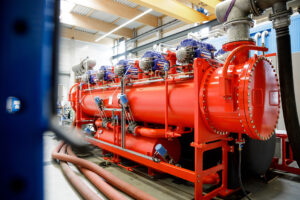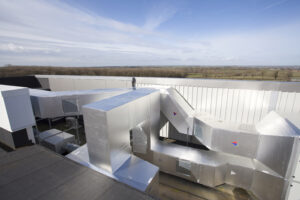Carrier celebrates 100th anniversary of Founder’s invention of centrifugal chiller
DUBAI, UAE, 30 June 2022: On the evening of May 22, 1922, Willis Haviland Carrier invited 300 people to a sheet metal shop in Newark, New Jersey, for a free meal and a boxing match, followed by the unveiling of the first centrifugal chiller technology, Carrier said through a June 30 Press release, adding that it celebrated the 100th anniversary of the invention of the centrifugal chilling machine that in many ways made the modern world possible. Carrier is a part of Carrier Global Corporation.
“[Willis] Carrier’s breakthrough invention opened the door to large-scale comfort air conditioning while improving the effectiveness of process cooling,” said Gaurang Pandya, President, Commercial HVAC, Carrier. “Each day we build on that legacy, innovating with purpose to create what’s next, get ahead of changing requirements, unleash the power of digital technology, run smarter with IoT and help customers deploy commercial HVAC solutions aligned tightly with their business objectives.”
Willis Carrier’s conception to combine a centrifugal refrigeration compressor with a shell, a new type of condenser and a chiller on one frame enhanced process cooling in factories around the world, Carrier said. Following the first installation of three centrifugal chillers at a Philadelphia chocolate factory in 1923, Willis Carrier’s innovation soon provided process cooling to rayon manufacturers in India and cracker factories in Mexico, the company said.
In 1924, Willis Carrier realized his dream of comfort cooling when the owners of a Detroit department store added centrifugal chillers, the company said. The centrifugal technology reliably and affordably delivered comfort air to the public in theaters, stores, restaurants, sports venues, ships, hospitals and office buildings, the company claimed.
A decade later, centrifugal refrigeration had driven process air into more than 200 industries, the company said. Food and beverage production became safer, hospitals were more comfortable and sanitary and new lifesaving drugs, such as penicillin, became possible, the company added.
By providing precise temperature and humidity, centrifugal chiller technology has supported the infrastructure of the modern digital age, including electronics of every type, semi-conductor chips, data centers and robotics, the company said. These new inventions and new technologies couldn’t have existed without it, it added.
Sathya Moorthi, Managing Director, Carrier Middle East, said: “Carrier has evolved over the years from being a manufacturer of cutting-edge equipment to providing solutions that harness the power of variable frequency drives and IoT, ensuring that business-critical activities run at peak effectiveness, and provide operational efficiencies and insights. This demonstrates our commitment to continuously improving energy efficiency while enhancing the comfort levels of the occupants in the harsh Middle East climate conditions.”
Carrier said that while the fundamental physics of centrifugal technology have not changed in a century, its engineers have never stopped driving new advancements in centrifugal chiller technology. Today, the Carrier AquaEdge 19DV water-cooled chiller provides world-class energy efficiency with its unique free cooling and heat recovery options that boost the total energy savings of the system while using ultra-low global warming potential refrigerant, the company added. The AquaEdge 19MV water-cooled chiller offers a wide operating range in a greatly reduced machine size to replace older chillers, the company said, adding that both machines feature its unique EquiDrive two-stage back-to-back compressor technology to dramatically reduce energy consumption.
AHRI, others petition EPA on HFC phase-down rule
ARLINGTON, Virginia, 13 April 2021: The Air Conditioning, Heating, and Refrigeration institute (AHRI) today joined more than 35 other industry and environmental organizations in petitioning the U.S. Environmental Protection Agency (EPA) seeking uniform national standards for stationary air conditioning and commercial refrigeration equipment in the transition to climate-friendly refrigerants under the American Innovation and Manufacturing (AIM) Act. If promulgated, these standards will result in an additional half billion tons of CO2 reduction, over and above what already is projected to be achieved by implementation of the AIM Act, AHRI said through a Press release.
The federal standards sought by the AHRI petition align with similar standards already in place in nine states. The Natural Resources Defense Council (NRDC), the Association of Home Appliance Manufacturers (AHAM), and the Environmental Investigation Agency (EIA) submitted similar petitions under the AIM Act, AHRI pointed out.
For new residential and light-commercial central air conditioning equipment, the petition, AHRI said, seeks a regulation requiring that equipment manufacturers use refrigerants with a global warming potential (GWP) of 750 or less in equipment made after January 1, 2025, with the exception of variable refrigerant flow (VRF) equipment, whose deadline would be January 1, 2026. These transition dates would align the country with the dates adopted in December 2020 by the California Air Resources Board (CARB) and nine additional Climate Alliance states, AHRI said.
For commercial refrigeration and chiller equipment, the petition seeks the GWP limits and transition dates according to the table below:
Through these petitions, AHRI said, a broad variety of stakeholders, including itself, hope to demonstrate that sufficient consensus already exists and that a regular notice and comment rulemaking would adequately represent all material interests, thereby allowing the agency to forego the negotiated rulemaking process it must consider – but is not required to undertake – for such petitions, pursuant to the AIM Act.
AHRI said its petition emphasizes that as a general matter, “the U.S. HVACR industry already is proceeding with the requested transition date as its goal; granting this petition provides order and structure to the market and streamlines industry preparation”.
The transition dates contained in its petition, AHRI said, allow “sufficient time for careful planning and preparation, both to avoid excessive costs that can unduly burden consumers, and to ensure all safety and other associated standards can be met”, according to the petition. “For example, contractors and technicians must receive appropriate training, state and local building codes must be updated and changed, and supply chains and distribution networks must be modified,” AHRI said.
“While AHRI has long believed that an earlier transition would not allow enough time for manufacturers to prepare, we have been equally clear that a later transition date would put long-term compliance with the AIM Act at risk,” said Stephen Yurek, AHRI President & CEO. “Aligning these dates also reduces costs for consumers and ensures long-term availability of energy-, environment-, and life-saving refrigerants for climate control and for the cold chain for food, vaccines, and other medicines.”
AHRI, the U.S. Department of Energy, CARB and other stakeholders have invested more than USD 7 million in research into alternative refrigerants in preparation for this transition, AHRI said, These more climate-friendly alternatives, it added, are in use today in Europe, Australia, Japan, Thailand and in more than 90% of new passenger vehicles currently sold in the United States.
ENGIE Refrigeration bets on sustainable refrigerant
LINDAU ON LAKE CONSTANCE, GERMANY, 23 February 2021: ENGIE Refrigeration has added a new refrigerant to its portfolio. R-515B is now available for QUANTUM chillers as an alternative to R-1234ze, it said. R-515B is eco-friendly, non-toxic and non-combustible and, thus, especially safe, it said. With the introduction of the new refrigerant, the company said it is setting a clear example for more sustainability.

R-515B is available for QUANTUM models as an alternative to R-1234ze. Source: ENGIE Refrigeration
ENGIE said it is one of the first manufacturers in the world to use the refrigerant R-515B. It was developed as an alternative to R-134a and can be used instead of R-1234ze in the form of a drop-in refrigerant, it added. “Refrigerant R-515B combines the positive properties of a 77% lower greenhouse potential than R-134a with a classification as safety level A1 according to EN 378-1,” Daniel Keller, Head of Product Management, ENGIE Refrigeration, said. “This means that unlike R-1234ze (A2L), it is considered a non-combustible safety refrigerant.”
R-515B is an azeotropic mixture, 91.9% R-1234ze and 8.9% R-227ea, ENGIE said. With a GWP value of 293 (IPCC-AR4*) and 299 (IPCC-AR5**), R-515B meets the requirements of the F-Gas Regulation – until at least 2030, the company said. Another important advantage for companies operating existing machines run on R-134a is that because R-515B is classified as A1, no additional safety measures need to be taken for the machine room containing the chiller or heat pump, the company said.
From February 2021, the air-cooled, water-cooled and split models of the QUANTUM series are available with R-515B as an alternative to the previous standard refrigerant, R-1234ze, ENGIE said. “With the new refrigerant, R-515B, the chiller achieves almost the same refrigeration capacity and energy efficiency as with R-1234ze,” Keller said. “This means that R-515B is suitable for customers from all industries that require optimal refrigeration capacity and also wish to switch to an eco-friendly and sustainable refrigerant.
Kingspan Insulation launches product for external ductwork applications
 DUBAI, UAE, 5 January 2021: Kingspan Insulation launched the KDuct, which the company described in a Press release as catering to external ductwork applications.
DUBAI, UAE, 5 January 2021: Kingspan Insulation launched the KDuct, which the company described in a Press release as catering to external ductwork applications.
According to the company, the KDuct incorporates its pre-clad ductwork system, made of thermoset, fibre-free pre-insulated duct board with a heavy-duty outer jacket. The company described the product as ideal for external applications, plantrooms, risers, congested spaces and lightweight specifications. The KDuct, Kingspan claimed, offers high performance, rigid, closed-cell insulation core, manufactured with a blowing agent with zero Ozone Depleting Potential (ODP) and low Global Warming Potential (GWP). At the same time, it said, the panels are faced on both sides with an embossed aluminium foil. The new product line would provide ultra-strength and rigidness; cost-savings over traditional exterior ductwork; extra-low air leakage, which does not allow conditioned air to escape; and high-compressive strength, among several other benefits, the company said.
Sarmad Fakhri, Managing Director, Kingspan Insulation, said, “KDuct Ductwork system would help our customers to save extra cost and time due to its lightweight and single-fix properties.” Unlike the traditional approach to ductwork construction, which requires sections to be lagged with insulation, once installed, the KDuct panels are pre-insulated with a high-performance insulation core, the company said. This single-fix and lightweight design, the company added, reduces installation time and transfers the cost benefits to the building owners.


